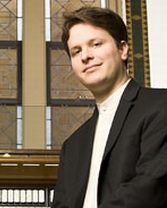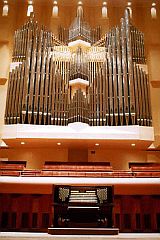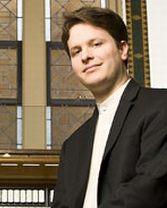
Photo by Christina Wilson
In the face of such prodigious feats, the skeptics among us nevertheless will ask, “Fine, but does he have anything to say as an artist?” A large and highly attentive crowd showed up at Davies Symphony Hall on Sunday to find out.
He began his program with an overly exuberant reading of Mendelssohn’s F-minor Sonata, and he was not shy about approaching this stately, often severe piece with a bit of panache. After an exceedingly liberal interpretation of the contrapuntal first movement, using excessive rubato and phrasing that was not particularly well-suited to the composer’s classicist tendencies, he calmed down in the second movement. Still, he never hesitated to expand on Mendelssohn’s original idea of two voices, using a broad scope of tonal colors as found in Davies’ vast Ruffatti organ, now 25 years old.
He approached the Recitativo section the same way, turning what should have been an accompanied solo into a series of antiphonal choruses. In the Finale, in which the composer calls for forte registration from the beginning, Jacobs started with a quiet, sparkly registration, building up to full organ at the end. This type of playing would seem to better serve music of Lizst than Mendelssohn. And yet, even when Jacobs began to rewrite the end of the Finale, repeating chords that are normally tied for several bars as if he were trying to emphasize the rhythm, I pictured the composer turning over in his grave, but with a smile.
Jacobs’ approach to Bach’s Prelude and Fugue in A Minor was far more deferential, but still reminded me of the older performances that used to be heard on recordings before the early-music Nazis took over. In addition to combining different registrations and colors in the Fugue, Jacobs also did something that would have been considered anathema by most organists: He used the swell pedal, ever so subtly. The pedal cadenza at the end was appropriately ferocious.
Intimations of Greatness

The second half of the program was devoted to one work, the Fantasy and Fugue on the Chorale Ad nos ad salutarem undam, by Liszt. Equal in scope to the composer’s B-minor Sonata, it remains a challenge to performer and listeners alike, purely because of its length (30 minutes) and a theme (an insubstantial, eight-bar affair taken from Meyerbeer’s opera Le Prophète) which, typically in the manner of Liszt, is relentlessly repeated, transposed, transmogrified, and otherwise developed to within an inch of its life.
Jacobs miraculously held the audience’s attention through a multitude of tonal changes (almost all of which were executed flawlessly: amazing, since Jacobs performed from memory), as well as fluid technique and a clear sense of where the music was heading at any given moment. The only flaw in the interpretation came during the final moments of the Fugue, when Jacobs inexplicably decided to move to a subsidiary keyboard in the middle of a climactic forte section, bringing back some of the quiet, sparkly sounds heard earlier during the Mendelssohn. The effect was like getting off an Amtrak train in the middle of nowhere in order to ride a model railroad.
Just the same, when Jacobs arrived at the station, pulling out all the stops (including even the bell-star mechanism), you knew he had arrived. He was given a standing ovation. After the recital, I overheard an elderly woman saying to her husband, “You know, on those big organs, you have to control everything. It’s not like a Yamaha.” No, it’s not.

